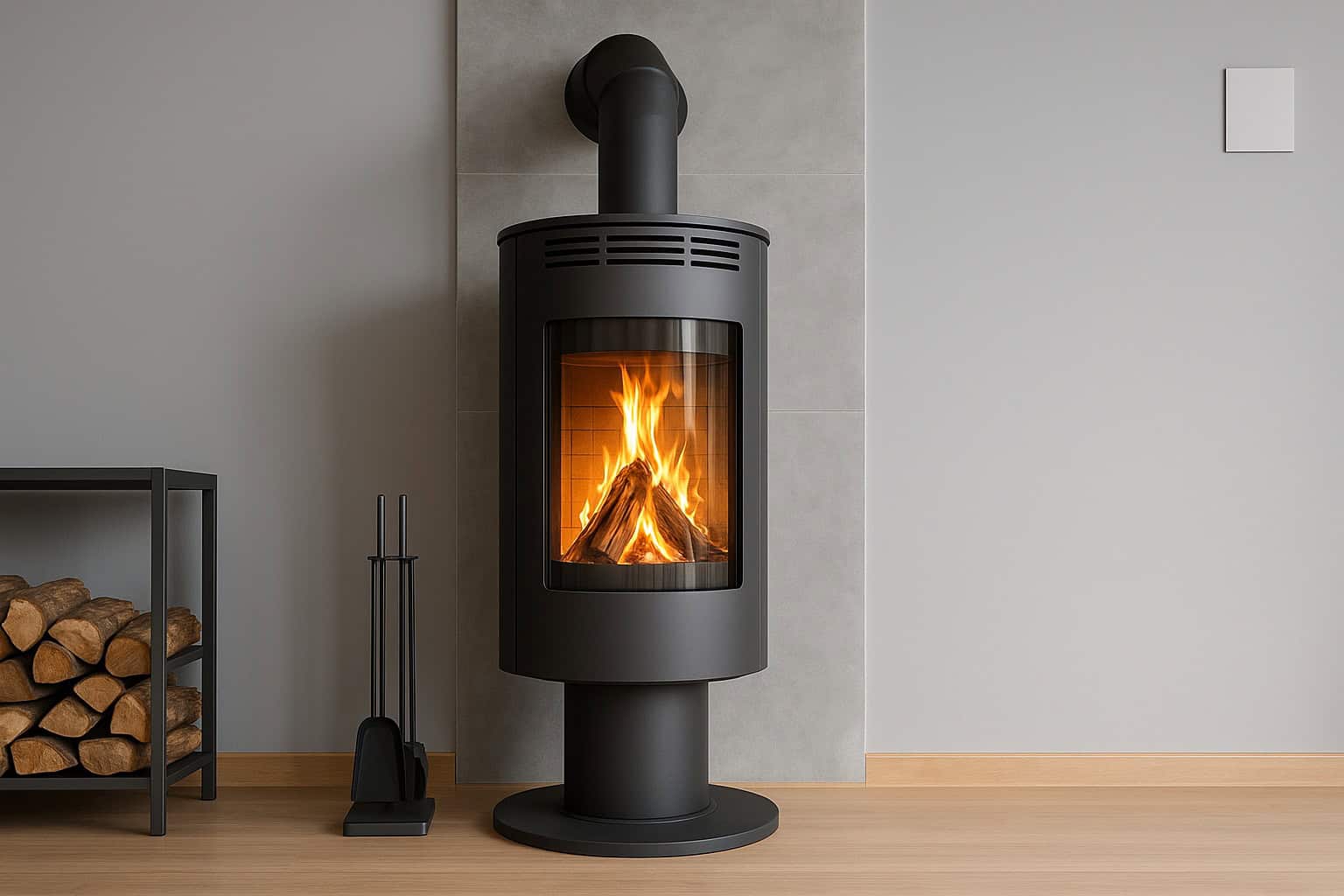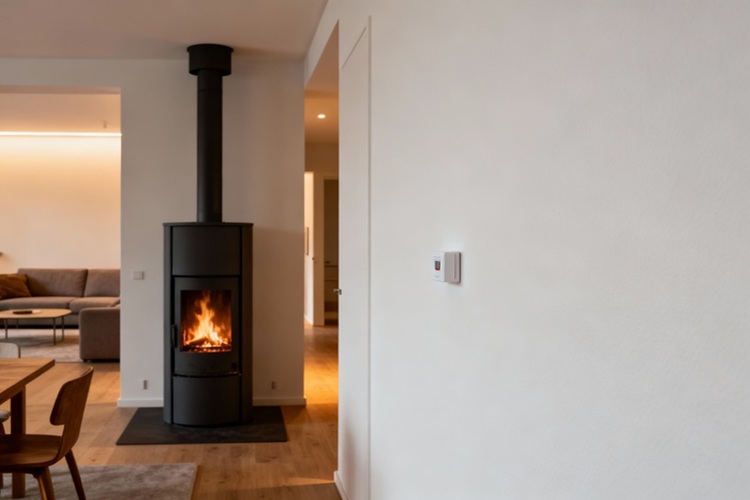Anyone operating a controlled domestic ventilation system, an extractor hood or a fireplace today can hardly avoid one device: the negative pressure monitor. It ensures that the interaction of fresh air, exhaust air and fireplace functions safely. Without it, it can be dangerous - especially due to backflow of exhaust gases or uncontrolled air exchange.
This article explains in detail what a negative pressure switch is, how it works, where it is used and why it is now mandatory in many buildings.
What is a negative pressure monitor?
A negative pressure monitor is a safety device that measures the difference in air pressure between the interior and exterior air. Its purpose: to prevent excessive negative pressure from developing in a closed room.
If, for example, a ventilation system or an extractor hood extracts air, a slight negative pressure is created in the room. If a fireplace or stove is in operation at the same time, this can cause flue gases or carbon monoxide to flow back into the living space. The negative pressure monitor detects this situation and reacts.
Typical tasks of the device:
- Monitoring of the differential pressure between indoor air and outdoor air.
- Switching off or blocking an exhaust air system if the negative pressure is too high.
- Protection of persons by avoiding dangerous exhaust gas backflows.
- Enable operation only if there is a sufficient supply of fresh air.
Why is a negative pressure monitor important?
Modern houses are built to be airtight. This saves energy, but poses risks as soon as several technical systems are running at the same time. Without equalizing fresh air, a dangerous negative pressure can quickly develop. This is particularly critical with open fires.
A vacuum switch provides double protection:
- Safety: It prevents flue gases from returning to the room.
- Efficiency: The systems work optimally because the air flows remain controlled.
- Comfort: No unpleasant draughts, no exhaust fumes in the living area.

Design and function of a negative pressure monitor
The functionality is based on a pressure sensor that measures the air pressure. As soon as a set threshold value is exceeded, the device automatically switches off the exhaust air source - such as the extractor hood - or issues a warning message.
Important components:
- Pressure sensor: measures the difference in air pressure.
- Control unit: evaluates the data.
- Switching contact or radio module: switches off connected devices as required.
- Connection pipes: connect the sensor to the interior and exterior.
Many models today have radio technology and can even communicate wirelessly with fans or hoods. This makes installation much easier - especially in existing buildings.
Individual pressure monitoring with air-Q
The air-Q air analyzer offers far more than ordinary negative pressure sensors. Its integrated sensor not only reliably measures positive pressure up to 1.2 bar, but also detects strong negative pressure down to 0.3 bar and even below, although the measuring accuracy may decrease slightly in this low range. The option of setting individual alarm thresholds is particularly practical.
Users can determine the pressure value at which a notification is triggered according to their requirements. The air-Q system supports various alarm types, from classic beeps and push messages to automated email notifications or individual automation solutions. This enables reliable, personalized monitoring in both private and professional environments, which contributes to a safe and healthy indoor climate and can be optimally linked to other smart home systems
Vacuum monitor for the chimney
A negative pressure monitor for fireplaces is mandatory if a stove or fireplace is operated with room air-dependent combustion and an exhaust air system is present at the same time. The guard ensures that no flue gases are forced back into the living space.
Process in operation:
- The extractor hood or ventilation system starts.
- The negative pressure monitor measures the pressure in the room.
- If a critical value is reached, the device stops the exhaust air system automatically.
- Operation is only enabled again when there is sufficient fresh air.
Its use is mandatory, especially in combination with a chimney sweep. He regularly checks the functionality as part of the fireplace inspection.
Vacuum monitor for ventilation system
A ventilation system ensures controlled air exchange. However, if it operates exhaust air fans, a pressure drop can also occur here. The negative pressure monitor for ventilation systems ensures that this difference does not become dangerous in combined systems with a fireplace, gas boiler or stove.
Practical advantages in everyday life:
- Automatic monitoring without manual intervention.
- No danger if several systems are used at the same time.
- Compatibility with modern smart home controls.
Some models can also be integrated into the building automation system so that faults are reported directly or exhaust air systems are controlled automatically.
Vacuum switch for extractor hood
Another classic is the extractor hood vacuum switch. Here, the device also protects against back pressure of dangerous gases, for example if the chimney is running while cooking.
Opportunities for integration:
- Direct connection to the hood via mains cable.
- Wireless connection to the vacuum sensor.
- Combination with window contact switch.
Some extractor hoods are already equipped with an interface module ex works, so that only the pressure sensor needs to be added. This reduces installation work and costs.
Radio solutions: Vacuum monitor with radio
The trend is towards wireless systems. A wireless vacuum monitor offers several advantages:
- No cable laying necessary - ideal for retrofitting.
- Flexible signal transmission via radio transmitter and receiver.
- Quick installation without interfering with the circuit.
- Simple coupling of several devices (e.g. hood, window, fan).
Radio is an efficient and clean solution, especially for renovations or in existing buildings. Despite radio transmission, users should pay attention to tested products with a stable connection and CE marking.
Legal requirements and standards
Whether a negative pressure monitor is mandatory depends on the combination of appliances in the household. As a general rule, if a room air-dependent fireplace (fireplace, stove, gas boiler) can be operated simultaneously with an exhaust air system (e.g. extractor fan or ventilation), a safety concept must be in place - usually in the form of a tested negative pressure monitor.
Important regulations:
- Firing regulations of the federal states (FeuVO)
- DIN EN 1443 and DIN EN 13384
- Technical rules of the chimney sweep trade
A discussion with the responsible chimney sweep will help to clarify the individual requirements. He can also recommend specific models and carry out the approval.
Assembly and installation
Installation should always be carried out by qualified personnel in order to avoid measuring errors or incorrect switching. The following always applies:
- The pressure sensor must not be exposed to strong air currents.
- The air pressure is measured between the room and the outside air.
- The control line or the radio signal couples the guard with the exhaust air system.
Many modern systems are plug-and-play and do not require a great deal of installation work. Solid calibration ensures long-term reliability.
Care, maintenance and service life
A vacuum switch is largely maintenance-free, but should be checked regularly. Dust or dirt on the pressure lines can impair the measuring accuracy.
Recommended:
- Visual inspection 1-2 times per year.
- Cleaning the pressure hoses with dry air.
- Function test during the annual chimney service.
Long-life devices have robust sensors and usually last more than 10 years before a readjustment is necessary.
Advantages at a glance
- More safety with simultaneous use of oven and exhaust air systems.
- Protection against carbon monoxide and flue gases.
- Automatic switch-off in case of danger.
- Energy efficiency through controlled air exchange.
- Easy integration into existing systems, also via radio.
Common misconceptions about vacuum switches
Many homeowners think that a slight pressure drop is harmless. In fact, just a few pascals of negative pressure are enough to disrupt the flow of flue gas from a chimney. The assumption that an open window is always sufficient as a fresh air supply is also only partially true - because in practice this is often forgotten. The negative pressure monitor prevents precisely this source of human error.













